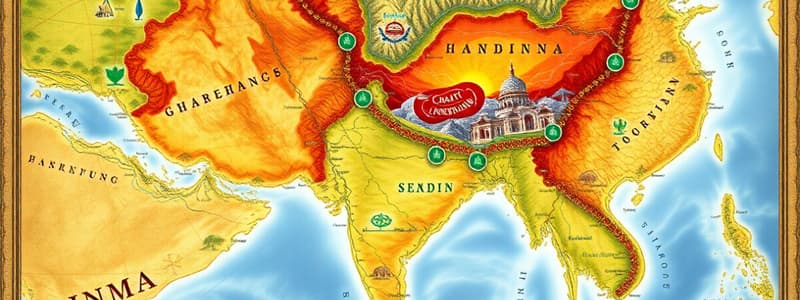Podcast
Questions and Answers
What year was Al-Idrisi's map of the Indian subcontinent created?
What year was Al-Idrisi's map of the Indian subcontinent created?
1154 CE
In which decade was the French cartographer's map of India produced?
In which decade was the French cartographer's map of India produced?
1720s
How does Al-Idrisi's representation of south India differ from modern expectations?
How does Al-Idrisi's representation of south India differ from modern expectations?
In Al-Idrisi's map, south India is positioned where north India is expected.
What is a cartographer?
What is a cartographer?
What language are the place-names marked in on Al-Idrisi's map?
What language are the place-names marked in on Al-Idrisi's map?
What differences do you notice between the level of detail in the coastal areas compared to the inland areas on Map 2?
What differences do you notice between the level of detail in the coastal areas compared to the inland areas on Map 2?
How did the meaning of the term 'Hind' evolve from the thirteenth century to the early sixteenth century?
How did the meaning of the term 'Hind' evolve from the thirteenth century to the early sixteenth century?
Why might European sailors and merchants find Map 2 particularly useful?
Why might European sailors and merchants find Map 2 particularly useful?
What impact does the changing context have on the meanings of historical terms?
What impact does the changing context have on the meanings of historical terms?
In what way does the use of the term 'Hindustan' today reflect its historical roots?
In what way does the use of the term 'Hindustan' today reflect its historical roots?
Flashcards are hidden until you start studying
Study Notes
Maps and Cartography
- Al-Idrisi's map from 1154 CE provides a detailed view of the Indian subcontinent, with place-names in Arabic.
- A French map from the 1720s shows a transformed perspective of India, marking significant geographical changes.
- The reversal of locations in these maps highlights the evolution of geographical understanding over time.
Terminology Changes
- The term “Hind” originally referred politically to lands between the Ganges and Indus during the thirteenth century but evolved to represent a broader cultural identity in the sixteenth century.
- "Hindustan" transitioned from a political term to signify the geographical and cultural essence of the subcontinent, forming the basis for modern references, like Hindi language.
Paper Usage and Historical Records
- In the thirteenth century, paper was scarce; scholars reused manuscripts, while by the fourteenth century, paper became more accessible for common transactions.
- Manuscripts were records of laws, teachings, and daily transactions, often difficult to use due to manual copying errors over generations.
Scribal Practices and Challenges
- The problem of differing manuscript versions due to generations of hand-copying poses significant challenges for historians needing to reconstruct original texts accurately.
- Miniature paintings occasionally illustrated manuscripts, with their exquisite quality often leading to their separation from the original texts for sale.
Social and Economic Developments (700-1750)
- Mobility increased as groups sought opportunities; notable examples include the rise of the Rajputs, who identified with Kshatriya status.
- The period witnessed technological advancements like the introduction of the spinning wheel and firearms, alongside new crops such as potatoes and coffee.
Political Structure and Regional Dynamics
- Major empires like the Tughluqs and Mughals encompassed diverse regions a distinct social and economic lifestyles.
- Jatis (sub-castes) emerged, exhibiting flexibility in status based on power, influence, and resources, alongside established norms managed by village assemblies.
Linguistic Diversity
- Amir Khusrau noted multiple regional languages, including Sindhi, Lahori, and Kashmiri, contrasting with the ancient Sanskrit, primarily known among Brahmanas.
- The changing landscape of language reflects historical and regional distinctions.
Religious Evolution
- During this millennium, local religious practices evolved alongside social organization, including the worship of personal deities and the role of Brahmanas as authoritative figures.
- This period marked significant transformations in spiritual beliefs tied closely to community structures.
Geographic Identity
- By 700 CE, distinct regions with specific languages and cultural attributes existed and were often tied to particular ruling dynasties.
- Regional conflicts shaped the development of empires, with varying degrees of stability impacting the cultural landscape of the subcontinent.
Historical Records
- The analysis of texts and chronicles from this thousand-year span remains complex due to variations in meaning and context over time.
- Significant events, technological introductions, and social changes shaped the subcontinent's evolving identity and historical interpretation.
Studying That Suits You
Use AI to generate personalized quizzes and flashcards to suit your learning preferences.



